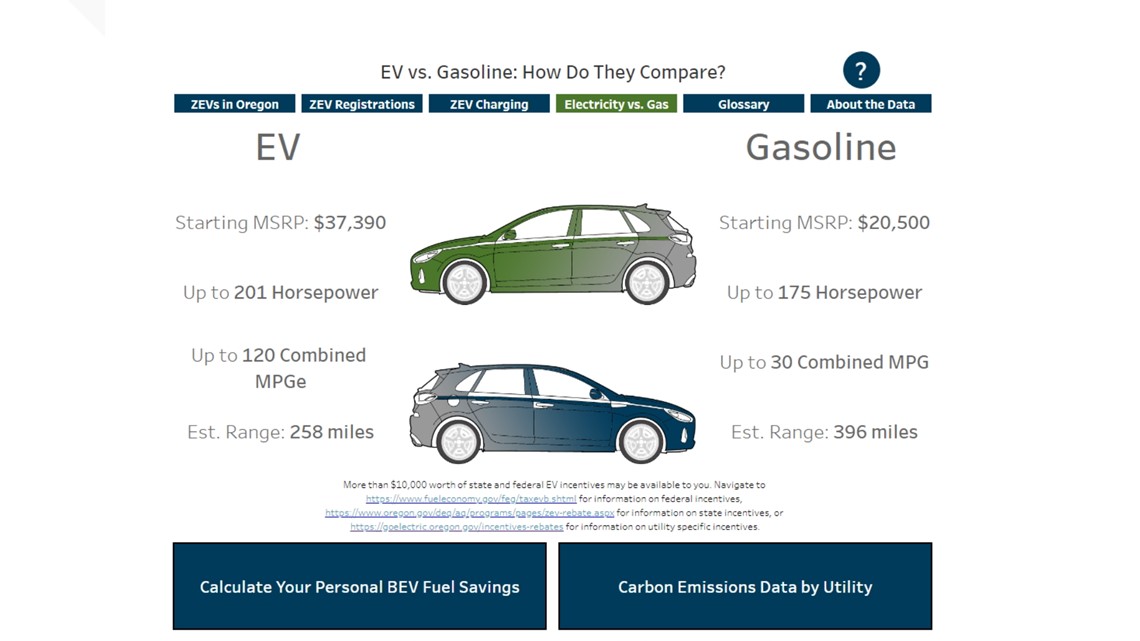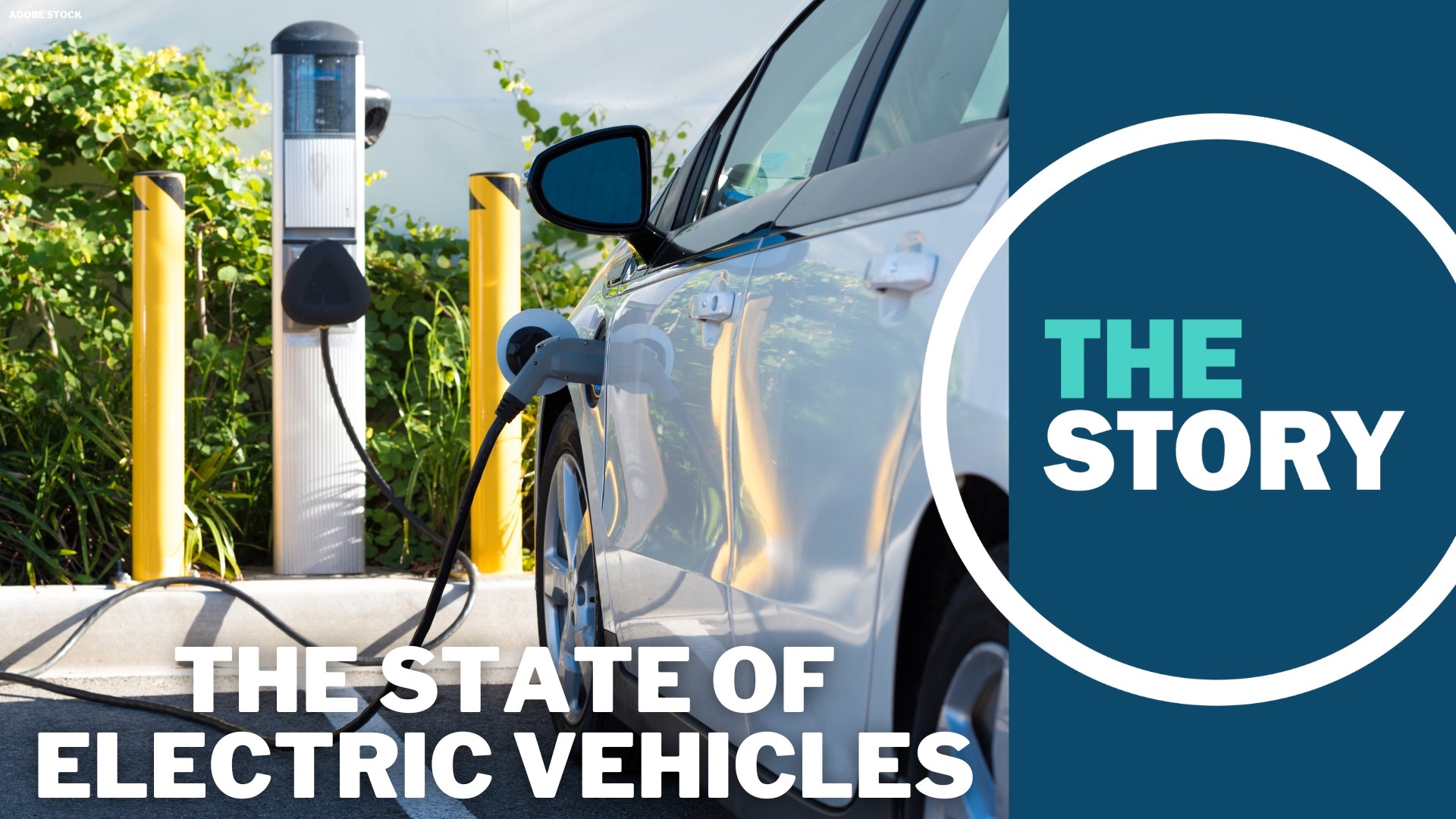PORTLAND, Ore. — With Earth Day coming up on Saturday, this week is "Good Energy" week at KGW. Part of that coverage begins with looking at how the transition to electric vehicles is going in Oregon.
The latest numbers from the state of Oregon, updated in November 2022, show more than 60,000 electric or plug-in hybrid vehicles registered in the state. The number is likely even higher than that by now.
Despite the number of EVs already in the state, there are stiff headwinds to ownership these days. The first and biggest hurdle is the cost. A graph from the Oregon Department of Energy shows the issue in rough numbers.
The graph compares two very similar vehicles, where the only real difference is the fuel source: a 2021 Hyundai Kona ICE vs. a 2021 Hyundai Kona EV. Using what ODE calls "general numbers," the gas version costs roughly $20,500, while the electric version starts around $37,300.
Taking these numbers as a baseline, we can expect an EV to cost about $17,000 more than a comparable gas vehicle.


The federal government offers up to $7,500 in tax credits for EVs, although the list of which vehicles qualify is changing this week. The state of Oregon offered between $2,500 and $7,500 in rebates for buying electric, but the program is going to run out of money at the end of the month and will then go on hold.
There's also the added cost of having to buy a home charger. Utilities offer money to help with that as well. In the Portland area, Pacific Power and Portland General Electric offer $500, or $1,000 for people on lower incomes. Those can help, but it remains the more expensive option.
The electric vehicle market
Regardless, there's a fundamental change underway as more and more political and economic push will bend towards reducing greenhouse gases and combating climate change.
Someone with a front-row seat to that transformation is Jeff Allen. He's the executive director of a nonprofit called Forth. Its goal is to get rid of barriers for electric mobility. That may sound nebulous, but he is certainly a big advocate for electric cars.
"This is an incredibly complicated transition that we're making. And it's easy to get bogged down in all the things that could go wrong and all the things we're trying to do," Allen said. "But fundamentally it's an incredibly exciting and optimistic story. Driving an electric car today in the Pacific Northwest is like driving a car that gets 120 miles per gallon or more. And it's the only car you can buy that gets cleaner every year you drive it, because the grid is getting cleaner."
Last week, the Biden administration announced new rules through the U.S. Environmental Protection Agency which could have the effect of turbocharging electric car sales.
The proposed rules would cut allowable tailpipe emissions in half. It could mean that within just nine years, two out of every three new vehicles sold would be electric.
In the meantime, different rules taking effect Tuesday will impact which EVs get a federal tax credit.
Last summer, The Story's Pat Dooris visited the Herzog-Meier Volkswagen dealership in Beaverton. He was impressed by the Volkswagen ID.4 electric car — albeit a bit bewildered by the high-tech dashboard.
"Well this is kinda nice! It tells me how much battery I have there," Dooris remarked. "How far I can go ... it says I can go 734 miles?"
"Ah, no," the sales person replied. "179 right now. This is the odometer."
"Oh," Dooris said. "Oh, okay!"
Last summer, the biggest challenge was in getting vehicles to show rooms. Supply chain issues created a waiting list several months long. At the time, the ID.4 — which sells for between $35,000 and $55,000 — did qualify for the federal tax credit. By Tuesday it will be off that list.
The New York Times reports that this is happening because Volkswagen is still assessing its supply chain, certifying that the cars are assembled in North America and that key battery parts come from the continent. The chief executive for Volkswagen Group of America said he does expect the vehicle to qualify.
NYT reports that Volkswagen had the fourth most popular EV in America over the first quarter of 2023. The top three makers were Tesla, General Motors and Ford.
The Inflation Reduction Act and EVs
Congress passed the Inflation Reduction Act last August. The bill did a number of things, but part of it focused on promoting clean energy. When it came to EVs, then, the government is now only approving tax credits for vehicles from companies that essentially make their batteries and cars in America.
According to a federal list put out by the government, seven auto companies and 14 vehicles will qualify for the full $7,500 tax credit. Those include Tesla's Model 3 and Model Y, which are the best-selling electric vehicles in America. But the least expensive version of the Model 3 is only getting half of that credit because, according to the NYT, the battery is made in China.
There are also income restrictions that come along with the credit. Buyers cannot make more than $300,000 as a household. The vehicle has to be assembled in North America, critical parts of the battery must come from North America or qualifying trade partners and the vehicle must cost $80,000 or less if its an SUV, van or pickup; $55,000 or less for other vehicles.
To sum up — the auto industry appears to be getting serious about moving to electric, there are some changes in the tax incentives designed to bring down EV prices and the federal government is getting more involved in making the transition happen.
Advocates like Allen are urging people to get on board if they can afford to do so.
"It's one of the easiest, quickest, least painful things you can do to reduce your carbon footprint — and actually, electric cars are better cars right?" he said. "They're faster, they're fun, you don't have worry about stopping to get gas. So it really is a success story and we are accelerating that transition at an incredible pace."
Looking down the road
Like California and Washington, Oregon has now committed to phasing out new gas vehicles by 2035 — it's a big part of the reason why, alongside rising popularity, auto makers are making an increasing effort to put out competitive new EV options. California alone is a huge market for vehicles, and its consistently set more stringent emissions standards than the federal government.
The EV transition ties into a number of other big issues covered by The Story this year. Take tolling, for instance. A number of viewers have asked why the Oregon Department of Transportation isn't raising sufficient money for infrastructure projects through the state's gas tax. While it's only one part of a much larger issue, ODOT is quickly coming to a point at which gas tax revenues will fall off a cliff.
Right now, the state continues to tax gas vehicles by the gallon, while EV owners pay higher registration fees to compensate. But, as The Story reported in January, state officials have been thinking about this issue for years, and there's been a pilot "pay-per-mile" program quietly running in the background in order to test the viability of a gas tax replacement.
The pay-per-mile program, called OReGO, remains a relatively small initiative without many takers, and there's no sign just yet that the Oregon Legislature has coalesced behind a plan to roll out a full version ahead of the big transition in 2035.

